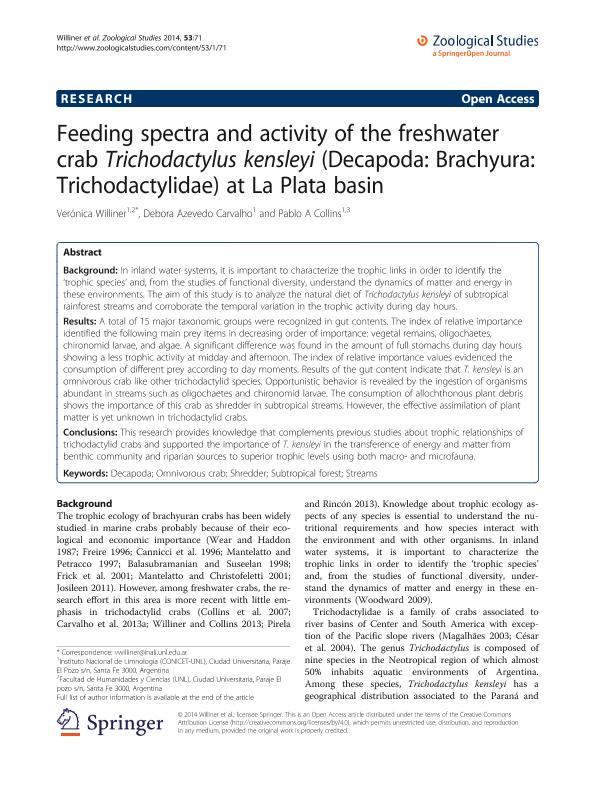Mostrar el registro sencillo del ítem
dc.contributor.author
Williner, Verónica

dc.contributor.author
de Azevedo Carvalho, Debora

dc.contributor.author
Collins, Pablo Agustin

dc.date.available
2017-12-21T14:24:56Z
dc.date.issued
2014-09
dc.identifier.citation
Collins, Pablo Agustin; de Azevedo Carvalho, Debora; Williner, Verónica; Feeding spectra and activity of the freshwater crab Trichodactylus kensleyi (Decapoda: Brachyura: Trichodactylidae) at La Plata basin; Springer; Zoological Studies; 53; 9-2014; 71-79
dc.identifier.issn
1021-5506
dc.identifier.uri
http://hdl.handle.net/11336/31200
dc.description.abstract
Background: In inland water systems, it is important to characterize the trophic links in order to identify the ‘trophic species’ and, from the studies of functional diversity, understand the dynamics of matter and energy in these environments. The aim of this study is to analyze the natural diet of Trichodactylus kensleyi of subtropical rainforest streams and corroborate the temporal variation in the trophic activity during day hours.
Results: A total of 15 major taxonomic groups were recognized in gut contents. The index of relative importance identified the following main prey items in decreasing order of importance: vegetal remains, oligochaetes, chironomid larvae, and algae. A significant difference was found in the amount of full stomachs during day hours showing a less trophic activity at midday and afternoon. The index of relative importance values evidenced the consumption of different prey according to day moments. Results of the gut content indicate that T. kensleyi is an omnivorous crab like other trichodactylid species. Opportunistic behavior is revealed by the ingestion of organisms abundant in streams such as oligochaetes and chironomid larvae. The consumption of allochthonous plant debris shows the importance of this crab as shredder in subtropical streams. However, the effective assimilation of plant matter is yet unknown in trichodactylid crabs.
Conclusions: This research provides knowledge that complements previous studies about trophic relationships of trichodactylid crabs and supported the importance of T. kensleyi in the transference of energy and matter from benthic community and riparian sources to superior trophic levels using both macro- and microfauna.
dc.format
application/pdf
dc.language.iso
eng
dc.publisher
Springer

dc.rights
info:eu-repo/semantics/openAccess
dc.rights.uri
https://creativecommons.org/licenses/by-nc-sa/2.5/ar/
dc.subject
Decapoda
dc.subject
Omnivorous Crabs
dc.subject
Shredder
dc.subject
Subtropical Forest
dc.subject
Streams
dc.subject.classification
Otras Ciencias Biológicas

dc.subject.classification
Ciencias Biológicas

dc.subject.classification
CIENCIAS NATURALES Y EXACTAS

dc.title
Feeding spectra and activity of the freshwater crab Trichodactylus kensleyi (Decapoda: Brachyura: Trichodactylidae) at La Plata basin
dc.type
info:eu-repo/semantics/article
dc.type
info:ar-repo/semantics/artículo
dc.type
info:eu-repo/semantics/publishedVersion
dc.date.updated
2017-12-18T15:03:36Z
dc.identifier.eissn
1810-522X
dc.journal.volume
53
dc.journal.pagination
71-79
dc.journal.pais
Alemania

dc.journal.ciudad
Berlín
dc.description.fil
Fil: Williner, Verónica. Consejo Nacional de Investigaciones Científicas y Técnicas. Centro Científico Tecnológico Conicet - Santa Fe. Instituto Nacional de Limnología. Universidad Nacional del Litoral. Instituto Nacional de Limnología; Argentina. Universidad Nacional del Litoral. Facultad de Humanidades y Ciencias; Argentina
dc.description.fil
Fil: de Azevedo Carvalho, Debora. Consejo Nacional de Investigaciones Científicas y Técnicas. Centro Científico Tecnológico Conicet - Santa Fe. Instituto Nacional de Limnología. Universidad Nacional del Litoral. Instituto Nacional de Limnología; Argentina
dc.description.fil
Fil: Collins, Pablo Agustin. Consejo Nacional de Investigaciones Científicas y Técnicas. Centro Científico Tecnológico Conicet - Santa Fe. Instituto Nacional de Limnología. Universidad Nacional del Litoral. Instituto Nacional de Limnología; Argentina. Universidad Nacional del Litoral. Facultad de Bioquímica y Ciencias Biológicas; Argentina
dc.journal.title
Zoological Studies

dc.relation.alternativeid
info:eu-repo/semantics/altIdentifier/doi/http://dx.doi.org/10.1186/s40555-014-0071-x
dc.relation.alternativeid
info:eu-repo/semantics/altIdentifier/url/https://link.springer.com/article/10.1186/s40555-014-0071-x
Archivos asociados
